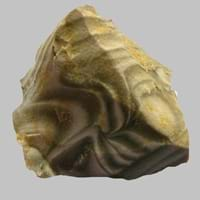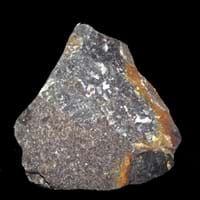Definition
Flint is a hard type of sedimentary rock that produces a small piece of burning material when hit by steel
Dolomite is a sedimentary rock containing more than 50 percent of the mineral dolomite by weight
Origin
Unknown
Southern Alps, France
Discoverer
Unknown
Dolomieu
Etymology
From Old English flint - a type of rock mainly known for high hardness and for giving off sparks when struck
From French, from the name of Dolomieu (1750–1801), the French geologist who discovered the rock
Class
Sedimentary Rocks
Sedimentary Rocks
Sub-Class
Durable Rock, Hard Rock
Durable Rock, Medium Hardness Rock
Group
Not Applicable
Not Applicable
Other Categories
Fine Grained Rock, Opaque Rock
Coarse Grained Rock, Fine Grained Rock, Medium Grained Rock, Opaque Rock
Texture
Banded, Rough
Earthy
Color
Black, Brown, Green, Grey, Red, White
Black, Brown, Colourless, Green, Grey, Pink, White
Durability
Durable
Durable
Scratch Resistant
Yes
Yes
Appearance
Glassy or Pearly
Glassy or Pearly
Interior Uses
Decorative Aggregates, Homes, Interior Decoration
Decorative Aggregates, Homes, Interior Decoration
Exterior Uses
As Building Stone, As Facing Stone, Garden Decoration, Office Buildings, Paving Stone
Garden Decoration, Office Buildings
Other Architectural Uses
Curbing
Not Yet Used
Construction Industry
Arrowheads, Cutting Tool, Spear Points
As a Flux in the Production of Steel and Pig Iron, As a Sintering Agent in Steel Industry to process Iron Ore, As Dimension Stone, Cement Manufacture, for Road Aggregate, Making natural cement, Manufacture of Magnesium and Dolomite Refractories, Production of Glass and Ceramics, Serves as an Oil and Gas Reservoir rock
Medical Industry
Not Yet Used
Taken as a Supplement for Calcium or Magnesium
Antiquity Uses
Artifacts
Artifacts, Jewellery, Monuments, Sculpture, Small Figurines
Commercial Uses
Creating Artwork, Gemstone, In fire-starting tools, Manufacture of tools, Metallurgical Flux, Jewelry, To ignite fire, Used in flintlock firearms
An Oil and Gas Reservoir, As a Feed Additive for Livestock, Gemstone, Metallurgical Flux, Production of Lime, Soil Conditioner, Source of Magnesia (MgO)
Types
Not Available
Boninite and Jasperoid
Features
Clasts are smooth to touch, Easily splits into thin plates, Has High structural resistance against erosion and climate
Host Rock for Lead, Traps for subsurface fluids like Oil and Natural Gas., Zinc and Copper Deposits
Archaeological Significance
Monuments
Not Yet Used
Used
Famous Monuments
Not Applicable
Data Not Available
Sculpture
Not Yet Used
Used
Famous Sculptures
Not Applicable
Data Not Available
Pictographs
Not Used
Used
Petroglyphs
Not Used
Used
Figurines
Not Yet Used
Used
Formation
Flint is formed by the decomposition and compaction of various organisms such as sponges and diatoms under the water.
Dolomite rocks are originally deposited as calcite or aragonite rich limestone, but during diagenesis process, the calcite or aragonite is transformed into dolomite.
Mineral Content
Silicon
Clay Minerals, Pyrite, Quartz, Sulfides
Compound Content
Silicon Dioxide
NaCl, CaO, Carbon Dioxide, Magnesium Carbonate, MgO
Types of Metamorphism
Not Applicable
Burial Metamorphism, Cataclastic Metamorphism, Contact Metamorphism
Types of Weathering
Not Applicable
Not Applicable
Types of Erosion
Chemical Erosion, Coastal Erosion, Water Erosion
Not Applicable
Grain Size
Very fine-grained
Medium to Fine Coarse Grained
Fracture
Conchoidal
Conchoidal
Porosity
Highly Porous
Less Porous
Luster
Vitreous
Vitreous and Pearly
Cleavage
Non-Existent
Perfect
Specific Gravity
2.5-2.8
2.8-3
Transparency
Translucent to Opaque
Transparent to Translucent
Density
2.7-2.71 g/cm3
2.8-2.9 g/cm3
Resistance
Heat Resistant, Impact Resistant, Pressure Resistant, Wear Resistant
Heat Resistant, Pressure Resistant, Wear Resistant
Deposits in Eastern Continents
Asia
Azerbaijan, China, Russia
China, India
Africa
Not Yet Found
Morocco, Namibia
Europe
Austria, Belgium, Cyprus, Denmark, France, Germany, Italy, Malta, Netherlands, Poland, Portugal, Romania, Spain, Sweden, Switzerland, Turkey, Ukraine, United Kingdom
Austria, Italy, Romania, Spain, Switzerland
Others
Not Yet Found
Not Yet Found
Deposits in Western Continents
North America
USA
Mexico, USA
South America
Bolivia
Brazil, Colombia
Deposits in Oceania Continent
Australia
New Zealand, South Australia
New South Wales, Queensland, Yorke Peninsula
All about Flint and Dolomite Properties
Know all about Flint and Dolomite properties here. All properties of rocks are important as they define the type of rock and its application. Flint and Dolomite belong to Sedimentary Rocks.Texture of Flint is Banded, Rough whereas that of Dolomite is Earthy. Flint appears Glassy or Pearly and Dolomite appears Glassy or Pearly. The luster of Flint is vitreous while that of Dolomite is vitreous and pearly. Flint is available in black, brown, green, grey, red, white colors whereas Dolomite is available in black, brown, colourless, green, grey, pink, white colors. The commercial uses of Flint are creating artwork, gemstone, in fire-starting tools, manufacture of tools, metallurgical flux, jewelry, to ignite fire, used in flintlock firearms and that of Dolomite are an oil and gas reservoir, as a feed additive for livestock, gemstone, metallurgical flux, production of lime, soil conditioner, source of magnesia (mgo).










